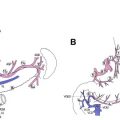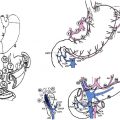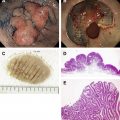Gastrointestinal stromal tumors (GISTs) are relatively rare mesenchymal tumors located within the submucosa of the GI tract. The defining characteristic of GISTs is the presence of the cell-surface antigen CD117 receptor tyrosine kinase, identified by immunohistochemistry. Currently the only cure for GIST is complete surgical resection. Imatinib has revolutionized the treatment of GISTs and has been used as adjuvant treatment after resection, and as treatment for locally advanced, recurrent, and metastatic GIST. Imatinib resistance has become a significant concern in the treatment of GISTs and other tyrosine kinase inhibitors that target different pathways are currently being studied.
Gastrointestinal stromal tumors (GISTs) are mesenchymal tumors that are thought to be derived from the interstitial cells of Cajal within the gastrointestinal tract. GISTs can occur anywhere along the gastrointestinal tract, from the esophagus to the rectum. The most common primary site is the stomach (50%), followed by the small intestine (36%), colon (7%), rectum (5%), and esophagus (1%).
Recent estimates place the incidence of GISTs at between 5,000 and 10,000 cases per year in the United States. Tran and colleagues conducted a population-based analysis of the Surveillance Epidemiology and End Results (SEER) database, including 1,458 patients with GISTs between 1992 and 2000. They found a yearly incidence of 0.68 per 100,000 during the study period. They also found a 1.5-fold higher incidence of GISTs in men (0.83/100,000) than in women (0.57/100,000). There was a higher incidence of GISTs in blacks (1.16/100,000) than in other races (0.97/100,000), with the lowest incidence in whites (0.60/100,000). The mean age of diagnosis was 62.9 years and the incidence increased with age. The impact of the anatomic location of GISTs on overall survival has been controversial in the literature. Some studies have suggested that gastric GISTs are less aggressive than GISTs of the lower gastrointestinal tract, whereas others suggest no difference. In this large SEER database study, the anatomic location had no impact on survival.
About 70% of patients with GISTs present with symptoms related to an enlarging abdominal mass, bleeding, or obstruction, with bleeding being the most common presenting symptom. The incidental finding of a GIST at the time of endoscopy or surgery is also not uncommon, occurring in about 20% of patients. At the time of presentation, as many as 50% of patients with GISTs present with distant metastases. Of the patients who present with distant metastases, about two-thirds have hepatic involvement. Patients present with extra-abdominal metastases or lymph node involvement much less commonly, less than 10% of the time. In one series of 200 patients, 30% of patients who presented with metastatic disease were able to undergo complete resection.
Preoperative imaging
Computed tomography (CT) scan is often the first imaging test used to evaluate a suspected intra-abdominal mass. CT can provide rapid and reproducible assessment of the size of the primary tumor and the relationship to surrounding structures. CT scan is also a useful method for evaluating metastatic disease and for determining resectable versus unresectable tumors. Small tumors are usually well circumscribed and of low soft tissue density on unenhanced CT scans. With intravenous contrast, these tumors typically show homogeneous enhancement. As the tumors get larger, they tend to show a patchy enhancement pattern with varying degrees of necrosis within the mass. CT scan can also identify the presence of metastatic lesions and is a useful tool for following lesions being treated with targeted therapy.
Magnetic resonance imaging (MRI) features of GIST are variable depending on the degree of necrosis and hemorrhage within the tumor. These tumors typically enhance with intravenous gadolinium and have low signal intensity on T1 weighted images and high signal intensity on T2 weighted images. MRI is mainly indicated when liver metastases are suspected, specifically to assess resectability and to differentiate from other types of liver lesions.
Endoscopic ultrasound (EUS) biopsy has become the preferred method for obtaining a tissue diagnosis for tumors in the upper gastrointestinal tract that are accessible by endoscopy. Biopsy may not be necessary if the tumor has classic endoscopic findings and is easily resectable, but should be performed before initiating preoperative targeted therapy. EUS and biopsy are also not indicated if the suspected GIST is symptomatic, as any bleeding or obstructing gastrointestinal tumor should be resected if the patient can tolerate surgery. The sensitivity of EUS fine-needle aspiration (FNA) cytology for GIST is dependent on tumor size, shape, and layer of origin. EUS-FNA has a higher sensitivity for tumors in the stomach when compared with tumors of the duodenum.
Stay updated, free articles. Join our Telegram channel

Full access? Get Clinical Tree






